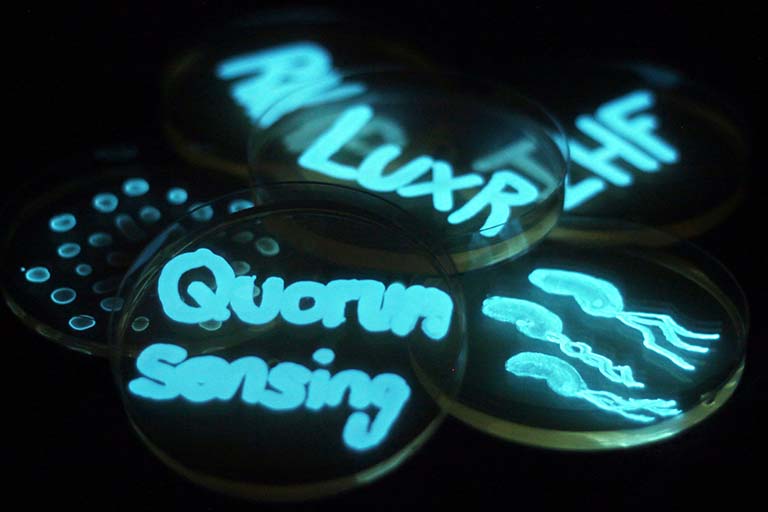Drug-resistant bacteria are a growing public health crisis. When antibiotics no longer work to treat an infection, what do you do? Julia van Kessel, assistant professor of biology, may have the answer.
“Most antibiotics that are currently used to treat disease work by preventing bacterial cell growth,” van Kessel said. “They are quite effective, but they also have a high potential to generate antibiotic resistance.”
Members of the van Kessel lab are taking a different approach. They study quorum sensing in bacterial pathogens. Quorum sensing is the regulation of gene expression in response to fluctuations in cell-population density. A few tiny bacterial cells generally cannot cause disease in a huge human host; however, when their numbers have multiplied, it’s a different story.
Once the bacteria reach a threshold—or “quorum”—where their numbers are great enough to enable them to work together, they change their gene expression (cell’s ability to convert information stored in its DNA into instructions for making proteins or other molecules for communication) to perform group behaviors. Group behaviors include actions as benign as emitting a faint bioluminescent glow or as dangerous as secreting toxins and making biofilms* and antibiotic-resistant genes. Bacteria launch their action at high numbers when billions of cells are present to make the action effective. Infection by bacteria is a nutritional strategy—it is the way that bacteria live off the nutrients provided by the host.
van Kessel wants to know when, why, and how much bacterial pathogens change gene expression. She wants to know why the timing of gene expression is important during infections.
To answer these questions, van Kessel lab members study the timing of gene expression of genes required for causing disease, such as those responsible for toxin secretion and cell motility (movement).
Their research will focus on bacteria in the Vibrio genus—V. cholerae, V. vulnificus, and V. parahaemolyticus. V. cholerae is the causative agent of the diarrheal disease cholera. Cholera is rare in the U.S. but common in developing areas of the world. Approximately 3 million cases of cholera occur each year, causing over 100,000 deaths. V. vulnificus and V. parahaemolyticus are responsible for the disease vibrosis in humans, which produces vomiting and fevers in some cases and skin infections in others. There are about 80,000 cases in the U.S. every year, with around 100 deaths. V. vulnificus and V. parahaemolyticus are also pathogens of shellfish and fish and are of great concern to the aquaculture industries.
Most of van Kessel’s research into quorum sensing will occur in the less infectious, bioluminescent bacterium V. harveyi. Its cellular mechanisms behave similarly to the more pathogenic vibrios. Although it is a pathogen to shellfish and fish, V. harveyi poses no risk to the lab members. It is also the vibrio for which the most is known about quorum sensing.
It has been established that the bioluminescent vibrios such as V. harveyi and V. fischeri produce light only when the cells reach high densities. The enzyme required to produce light is made in a “burst” when the cells start growing quickly. Researchers learned that the burst is controlled by bacterial proteins that produce and sense small molecules used for cell-cell communication.
Because of similarities, knowledge gained from studying V. harveyi can be extrapolated to the other pathogens to investigate how quorum sensing impacts bacterial physiology, infection, and toxicity.
The van Kessel lab has pinpointed the LuxR/HapR proteins as key targets for developing inhibitors of quorum sensing in pathogenic vibrios. These proteins are at the center of the quorum sensing pathway in vibrios. They control the expression of hundreds of genes which allow the bacteria to behave as groups and work together. LuxR/HapR proteins are the ones directly changing the expression of the genes for such things as toxin secretion, biofilm formation, and bioluminescence. If van Kessel can learn enough about how LuxR/HapR proteins function, drugs that target these proteins to block their activity can be developed. van Kessel notes that if the cells cannot change their gene expression, they cannot launch their attack of toxins and biofilms.


 The College of Arts
The College of Arts